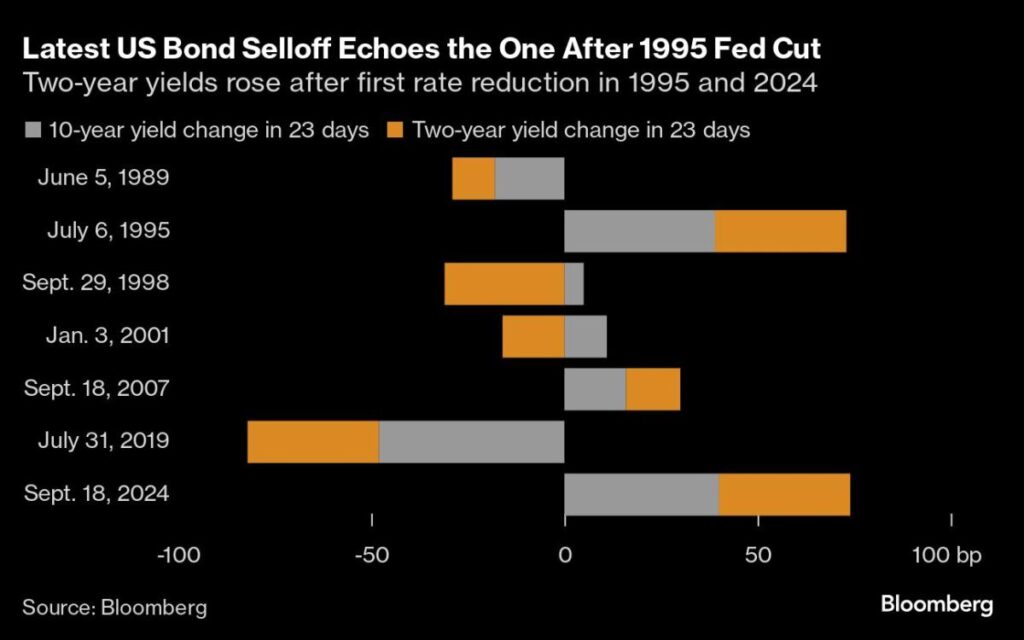In recent financial news, the U.S. dollar has shown strength against key currencies, reflecting a subdued risk appetite in Asian markets as investors adjust their expectations for Federal Reserve interest rate cuts. This shift comes as the U.S. economy demonstrates resilience, leading market analysts to predict a slow approach towards policy easing from the Federal Reserve. Treasury yields have experienced an upward trajectory, surpassing 4.2% for the first time since July, contributing to a global bond selloff. Japan’s sovereign bonds have followed suit, reaching their highest yield in 16 years. Asian equities have exhibited a lackluster performance, remaining stable but reflecting declines in Japan and only modest gains in South Korea and Australia. U.S. futures too show a slight downward trend amidst these developments, underscoring investor apprehensions about fiscal stability and potential economic slowdown.
Despite the overall subdued atmosphere in Asian markets, Hong Kong and mainland Chinese stocks have emerged as notable exceptions, fueled by an initiative from a government-affiliated think tank advocating for the issuance of special government bonds totaling 2 trillion yuan ($281 billion) to bolster market stabilization. This proposed measure highlights an increased focus on policy responses aimed at economic support, especially in light of global uncertainties. The overall market reaction indicates that investors have adjusted their outlook, responding to signals that suggest slower rate reductions by the Fed, amid concerns about broader fiscal deficits following upcoming presidential elections.
Significant commentary on the current monetary policy landscape has come from various financial leaders, including Bank of America’s CEO, who emphasized the need for a measured approach to interest rate cuts. The International Monetary Fund (IMF) has also weighed in by downgrading its global growth forecast for the upcoming year, raising alarms about potential risks stemming from geopolitical tensions, protectionist trade measures, and other global challenges. While the IMF acknowledges the successes of central banks in managing inflation, it simultaneously cautions that sustaining economic growth without slipping into recession poses a significant challenge moving forward.
In terms of market activity, two notable stock listings in Asia have captured investor attention. Tokyo Metro Co. saw its shares surge by 47% in a highly successful initial public offering (IPO), marking a significant milestone in Japan’s equity market. This IPO raised approximately 348.6 billion yen ($2.3 billion), signaling strong investor demand. Similarly, shares for China Resources Beverage Holdings Co. gained 14% in Hong Kong following a positive reception to one of the city’s largest IPOs this year. These developments indicate a regional appetite for new investment opportunities, though they exist within a broader context of caution regarding economic conditions.
As commodity markets react to evolving economic signals, oil prices fell following reports of increased crude inventories in the U.S., coupled with renewed diplomatic efforts from the Biden administration for a cease-fire in the Middle East. This shift in the oil market was accompanied by a fall in gold prices, which had previously reached record levels. Meanwhile, cryptocurrencies are generating intense speculation, with traders placing bets on Bitcoin achieving $80,000 by the end of November, regardless of the U.S. election outcome. In corporate news, companies like Texas Instruments and Starbucks have provided downbeat forecasts, indicating potential challenges ahead, particularly with declining sales figures and other operational issues affecting performance.
Looking ahead, market participants are poised for several significant events, including interest rate decisions from Canada, consumer confidence metrics from the Eurozone, and a series of earnings reports from high-profile companies. Anticipation is building for insights from the Federal Reserve’s Beige Book, which will provide further understanding of economic conditions influencing monetary policy, as well as critical data on home sales and consumer sentiment. As the financial landscape continues to evolve, the delicate balance of equity markets, currency fluctuations, and global economic indicators will likely shape investor strategies in the coming weeks.

